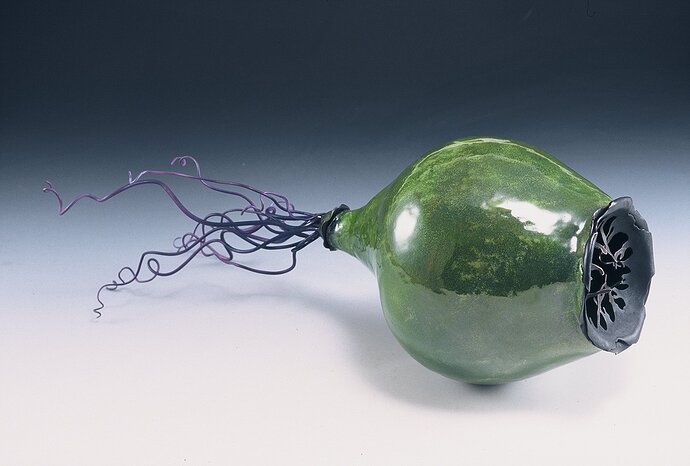Materials: Copper, Vitreous Enamel, Color Pencils, Patina
Dimensions: 32.4 X 10.5 X 11.4 cm
The vessel is a form inspired by sea anemones. The characters of the vessel are represented by the duality of robust and frail. The green body of the vessel is the robust part, in which it is strongly constructed by the raising technique into a round and bulbous form. An organic shape with curved contour and the vibrant colors suggest the fluidity, organicity, and spontaneity of the anemones, as well as suggesting the underwater feeling. The purple frail and delicate lid and wires on the narrow end contrast with the sturdy body. The wires at the end are used to represent and mimic the fragile and flimsy tentacles of the anemones. The rolled edge and the tentacle-liked element on the lid also convey a sense of delicacy and frailty. The choice of enamels is to suggest the symbiotic relationship between the anemones and green algae. Different shades of green and purple are to give a more naturalistic look and a more pleasant yet vibrant visual effect.
Photo credit: Helen Shirk
Karen Lee
Hong Kong, Hong Kong
Body ornaments have always played a big part in my life; I am infatuated with metalwork and jewelry and passionate about jewelry-making at a very early age. In the process of creating a piece of artwork, there is always a special and intimate connection between the piece and the artist. It is not only about the patience and the careful handling of the materials and the actual pieces; the most intimate and enjoyable part is that I can incorporate my own ideas and design pieces to express my interests, intentions, as well as personal feelings and emotions. Most of the pieces I created are based on my personal history, experiences, and my love for nature.
The exhibition explores metal works whose primary theme is color embraced as their primary visual focus, whether that be using colored materials, exploring creating colored surfaces, or encasing the object in color.
As the world's largest jewelry related internet site, Ganoksin strives to develop exhibitions showcasing work from around the world. This exhibition was open to all metalsmiths, professional and amateur, advanced and beginner.
In total 303 artists contributed 814 show pieces for the permanent online exhibition.
The exhibition was curated by Beth Wicker, President of the North Carolina Society of Goldsmiths in the United States, and Adjunct Instructor at Northeastern Technical College in South Carolina. Director of the exhibition is Hanuman Aspler, founder of The Ganoksin Project, the world's largest internet jewelry site.
Hue is one of the primary properties of color, it refers to the place the color occupies on the visual spectrum. Humans have used hues throughout time, to create cave paintings, to decorate themselves, their clothing and their housing.
Different hues have taken on different meanings throughout time. Gold traditionally has been a color of purity - the metal gold is relatively unchangeable, and the hue of gold has come to stand for gods and goddesses, for royalty, for durability and for purity. Red has often meant love, or passion. Hues often reflect the meaning of the seasons, with pastels referring to spring and the burst of new life after the pale hues of winter. Summer is reflected in vibrant, deep hues, followed by the browning of hues in the fall as plants go to seed and die, and the land turns fallow.
The worth of a hue has often been tied to what is necessary to make the pigment that creates the hue, and the expensive involved in the process. Often created from crushed stones that had to be mined and carried by caravan over thousands of miles, or from fermented roots of plants only grown in certain areas, or the carapaces of rare insects - the creation of hue in a way that could be used by man was an involved and generally expensive process.
In today's world metalsmiths have access to perhaps the widest range of materials and hues in the history of man - and in some of the most affordable ways ever.
This exhibition celebrates hue - color - as an integral, inherent element of the work. We talk of the "richness" of color, and examples of this abound here. One expects hues from the colors of gemstones used in metalsmithing, but we also have hues from some less expected places. Glass enamels are an ancient way of adding color, as are a variety of patinas. Today's artists also use synthetic man-made materials to add color in ways that didn't exist a century ago.
We invite you to enjoy this celebration of hue, and the ways hues and their use have changed over time.
